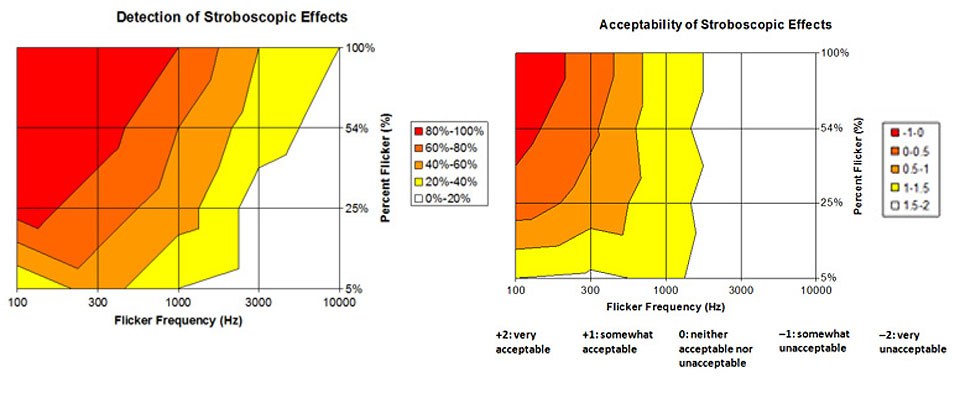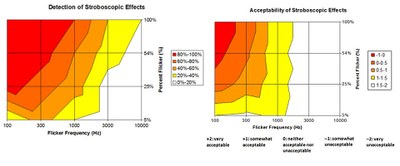Studies Published on Flicker Perception from SSL Systems - ASSIST to Release Related Recommendation
Flicker and stroboscopic effects have been a concern with solid-state lighting (SSL), and industry and the ENERGY STAR program have debated recently the effects of frequency and other driving modes on the perception and acceptability of flicker. To provide further data and guidance in this area, the Lighting Research Center (LRC) at Rensselaer Polytechnic Institute has conducted human factors studies of flicker that were recently published in the Lighting Research and Technology journal. The studies, funded by the Alliance for Solid-State Illumination Systems and Technologies (ASSIST), will become the basis for future ASSIST recommends guidelines on flicker from SSL systems.
All electric light sources flicker, but the numerous ways in which LEDs can be driven creates the potential for a wide variety of flicker characteristics in SSL systems. These can be perceived directly if the flicker itself is visible, or indirectly through stroboscopic effects similar to the “wagon-wheel effect” where a spinning wheel appears to be moving slowly or be stationary under intermittent light. In early 2010, industry leaders from ASSIST asked the LRC to update the available research literature on perception of light source flicker through human factors studies. Previous research has shown at what frequencies direct flicker is perceptible, but ASSIST leaders expressed interest in identifying thresholds and acceptance levels for indirect perception of flicker and a means of predicting these levels for SSL and conventional light sources.
The studies, led by John Bullough, Ph.D., LRC senior research scientist, were designed to assess responses to flicker, specifically detection, acceptance and comfort. In the first published study, “Effects of flicker characteristics from solid-state lighting on detection, acceptability and comfort,” a table lamp in a laboratory was fitted with LED sources to produce different flicker frequencies, modulation depths, duty cycles (duty cycle is defined as the percentage of time a modulating light source is "on"), waveform shapes and correlated color temperatures. Study participants reported whether they detected flicker effects and if so, how acceptable they were. They also rated their visual comfort under each condition.
Dr. Bullough and colleagues found that although flicker was not directly visible at frequencies of 100 Hz or higher, indirect stroboscopic effects of flicker were perceptible even at 300 Hz. Lower modulation depths substantially reduced the perception of stroboscopic effects, and a higher duty cycle resulted in somewhat higher rated comfort than a lower duty cycle. Neither the shape of the flicker waveform nor the correlated color temperature of the light affected responses to flicker under the conditions studied.
“The results suggest that there is a tradeoff between the frequency and the modulation depth in the detection and acceptability of indirect flicker effects,” said Dr. Bullough. Building on these results, ASSIST and the LRC performed a follow-up study to systematically evaluate this tradeoff and look more closely at the relationship between frequency and percent flicker. A second paper describing this study has been accepted recently for publication.
With the published findings, ASSIST is developing a set of recommendations for manufacturers under its ASSIST recommends publication series, noted Nadarajah Narendran, Ph.D., LRC director of research and ASSIST organizer. “Since 2002, ASSIST’s leading industry stakeholders from both LED and traditional lighting have taken an active role in working with the LRC to solve technical and market problems through studies such as this,” said Dr. Narendran. “The results of this research by ASSIST can be used to help LED lighting manufacturers in developing systems that minimize the effects of flicker.” The recommendations will be made available for download later this year on the ASSIST website (http://www.lrc.rpi.edu/assist).
The first paper, “Effects of flicker characteristics from solid-state lighting on detection, acceptability and comfort,” is published in the online early access section of Lighting Research and Technology at http://dx.doi.org/10.1177/1477153511401983. The second paper, “Detection and acceptability of stroboscopic effects from flicker,” is forthcoming in the same journal. A project summary for both studies can be accessed at http://www.lrc.rpi.edu/programs/solidstate/assist/flicker.asp
About ASSIST:
The Alliance for Solid-State Illumination Systems and Technologies (ASSIST) was established in 2002 by the Lighting Research Center as a collaboration among researchers, manufacturers, and government organizations. ASSIST’s mission is to facilitate broad adoption of solid-state lighting by helping to reduce major technical and market barriers. The Lighting Research Center conducts research, demonstration, and educational activities on behalf of ASSIST. ASSIST is sponsored by Acuity Brands Lighting; Amerlux Global Lighting Solutions; Bridgelux; China Solid State Lighting Alliance; Cree; Everlight Electronics Co., Ltd.; Federal Aviation Administration; GE Lighting Solutions; ITRI, Industrial Technology Research Institute; Intematix Corp.; LG Electronics; LG Innotek; Lighting Science Group; Lite-On; NeoPac Lighting; New York State Energy Research and Development Authority (NYSERDA); OSRAM SYLVANIA/OSRAM Opto Semiconductors; Philips Lighting; POSCO LED; Sharp Laboratories of America; Seoul Semiconductor; United States Environmental Protection Agency; WAC Lighting.
About ASSIST recommends:
ASSIST has developed a publication program called ASSIST recommends to provide a set of formal recommendations to the LED and lighting communities about issues important for the reliable performance of LED lighting and its comparison to other light source technologies. The publications include recommendations for LED life definition, testing and measurement, best practice guides for different lighting applications, and recommendations for selecting LED lighting. All ASSIST recommends publications can be found at www.lrc.rpi.edu/programs/solidstate/assist/recommends.asp


